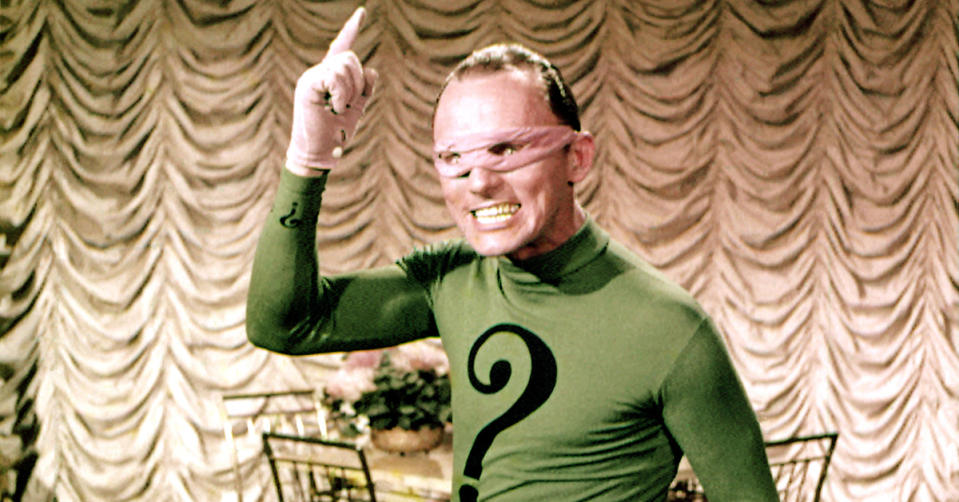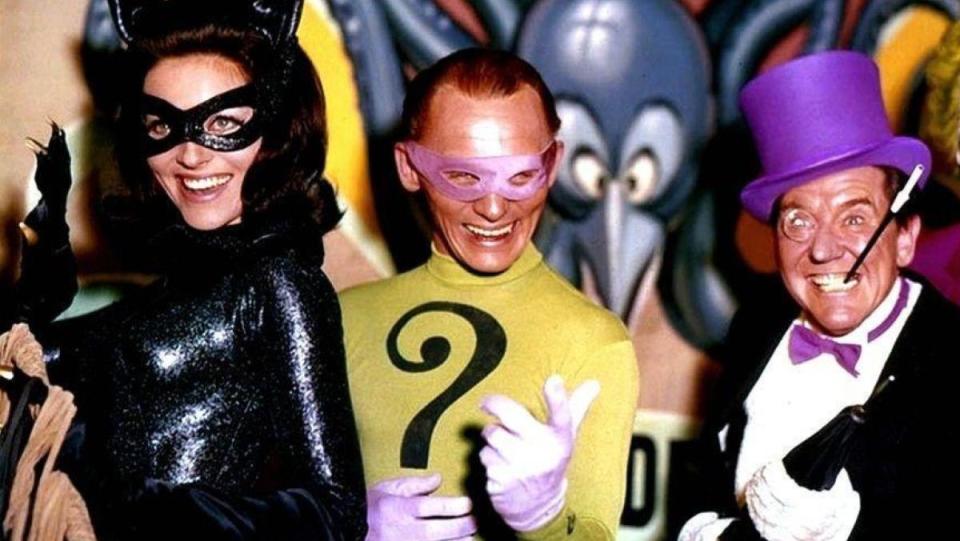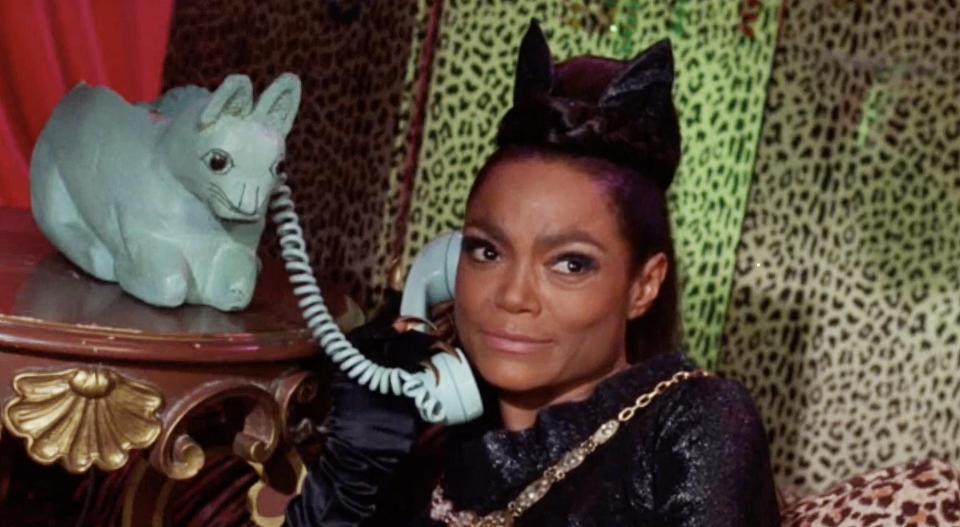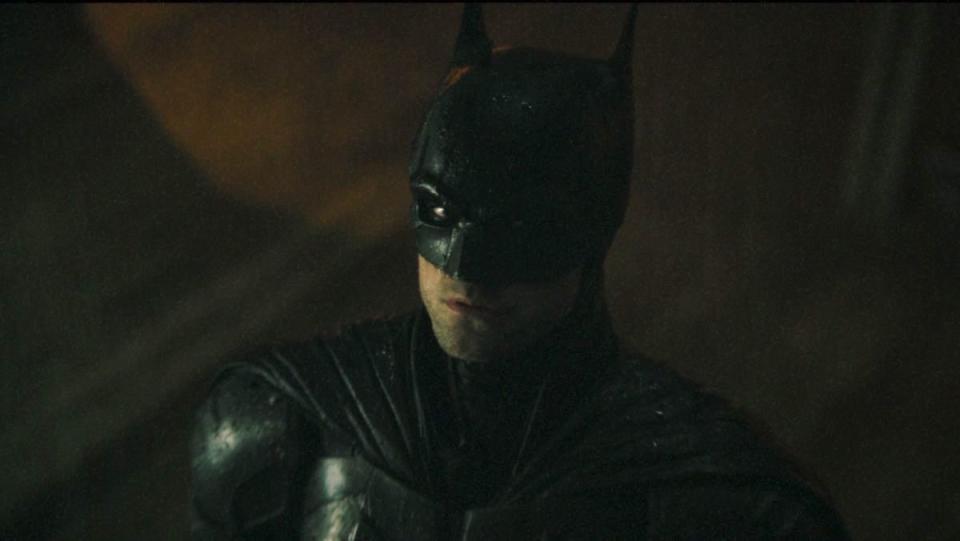THE BATMAN Couldn’t Exist Without BATMAN ’66
- Oops!Something went wrong.Please try again later.
- Oops!Something went wrong.Please try again later.
- Oops!Something went wrong.Please try again later.
The trailers for DC’s dark and demented new flick The Batman looks a world away from the bright campiness of the beloved Batman ’66 series. But there were seeds sown in that show that have clearly shaped Matt Reeves’ vision. From the rogues that Reeves selected to the fact that the Riddler had only been in a few comics prior to his appearance in Batman ’66 there’s a lot about the classic Batman TV series that’s made its mark on The Batman.
It’s not all hyperbole and theory either. In a recent interview with Esquire Middle East, Reeves revealed how much of an impact the ’66 show had on him. “The costume, the Batmobile, it was all very captivating. I didn’t see anything funny about it. I just thought ‘wow, Batman is really cool.'” That becomes text in The Batman, as Reeves translates the characters he grew up with on the small screen into his brutal and often bleak big screen world. And as he reintroduces viewers to the Riddler, Catwoman, and the Penguin, it’s hard not to think about Batman ’66.
The Riddler Before Batman ’66

Debuting in 1948’s Detective Comics #140, the Riddler was created by Bill Finger and Dick Sprang. In his first issue we learn that E. Nigma (later Nygma) became interested in puzzles after cheating on one in school as a—very old looking—child. It’s an intriguing backstory that essentially sets the Riddler up as a fraud. His entire origin as the “Prince of Puzzles” is based on cheating and scamming his young friends. After running a profitable but ultimately boring hustle at local carnivals he decided to reinvent himself as the Riddler. He first challenges Batman to solve a riddle on a giant crossword, then makes him solve an oversized puzzle—seeing a trend?—along with giant sized metal logic puzzles, a giant sized fun maze, and some giant corn!
It was an outrageous and fun debut, but it only led to one more appearance for the Riddler in the ’40s. He was back in Detective Comics #142 with more larger than life puzzles but the famed villain wouldn’t return again until 17 years later in 1965’s Batman #171. During the entertaining “Remarkable Ruse of the Riddler,” he tricks Batman into believing he’s turned over a new leaf in order to gain his attention once more. This third appearance would also play a large part in his role in Batman ’66, but we’ll get to that later.
It might seem hard to believe that he only had three appearances before Batman ’66 but that wasn’t uncommon for Golden and Silver Age comics. Characters often popped up and were never seen again. But as we know that was not the case with the Riddler, who would go on to become one of DC Comics’ most recognizable villains. And Batman ’66 played a huge part.
Batman ’66 and the Riddler

From the very first episode of Batman, the Riddler (played by Frank Gorshin in season one and three and John Astin in season two) took on a key role. Not only was he the first villain that the dynamic duo fought against, but the debut episode was based on his appearance in Batman #171. “Hi Diddle Riddle” recreated the jealous rogue trying to distract Batman and Robin from their feud with the Molehill Mob. And from there on he became a fan favorite and recurring antagonist of the series. His TV popularity was reflected in more regular appearances in the comics, and in 1966 he featured in four issues. That might not sound like a lot but it’s more than his grand total in the two decades before the series aired.
Soon, the Riddler would be joined by other famous villains like Mr. Freeze (George Sanders), the Joker (Cesar Romero), Catwoman (Julie Newmar), and the Penguin (Burgess Meredith). The choices that were made by Batman ’66 undoubtedly shaped who we see as key Batman rogues. Not least because Batman’s cinematic outings of the 80’s and 90s would see the villains from this roster represented time and again. And Matt Reeves is returning to that tradition.
The Riddler, Catwoman, and the Penguin

While the Riddler had made his impact in the show, it was the Batman ’66 movie that would introduce the team of baddies who would decades later make up Matt Reeves’ rogues gallery. The ridiculous romp saw Batman face down against some of his most famed foes. Catwoman (now played by Lee Meriwether), the Penguin, the Riddler, and of course the Joker. So that’s Matt Reeves’ entire rogues gallery—alongside Batman’s most famous foe—terrorizing Gotham over a half century before The Batman.
While the Joker might seem out of place in that lineup, rumors abound about the casting of Barry Keoghan. Though he’s officially cast as a member of the GCPD, many fans are convinced he’ll be playing Reeves’ new Clown Prince of Crime. So if that unconfirmed buzz turns out to be true, then Batman ’66 will have influenced one more key aspect of the film’s villains.
During a chat with Nerdist, Reeves revealed one of his favorite takes on the Dark Knight is Batman Returns. It makes a lot of sense, especially as director Tim Burton was influenced by Batman ’66. His villain roster took from the key crew of the Adam West series, and his second Batman film was meant to have a more direct lineage to the campy ’60s show. Originally, the Penguin’s father in the opening was going to be played by none other than Burgess Meredith. He had to pull out due to health issues. But it’s another example of how Batman ’66 influenced Batman adaptations for years to come. So in a cyclical way, by influencing Batman Returns—a film Reeves loved—Batman ’66 adds another layer of inspiration to The Batman.
Batman ’66 and Catwoman

One of the most memorable things about Batman ’66 are the many faces of Catwoman. The character was played by three different actresses during the show’s three seasons and a movie. In season one and two, she was brought to life by Julie Newmar with mischievous aplomb. In the film, Lee Meriwether took on the iconic role. But it was arguably Eartha Kitt as the third iteration of Catwoman who had the biggest impact. It was the first time a Black Catwoman became Batman canon, something that’s been continued throughout some on screen representations, most recently with Zoë Kravitz in The Batman.
Interestingly, when Batman ’66 debuted Catwoman hadn’t been in a DC comic for 12 years, thanks to the self-implemented Comics Code of America. In response to Fredrick Wertham’s Senate depositions, rules around representation of crime had kept the Cat in the bag since 1954. Batman ’66 changed all of that. Suddenly, Catwoman was on every TV screen in America. But it would take until 1967 for her to return to a main Batman comic book. It’s questionable whether she would have returned at all without Batman ’66. Selina Kyle broke back into DC Comics in Batman #197, and she’s since become a publisher and pop culture stalwart with her missing years in the distant past.
The Lasting Impact of Batman ’66

Aside from its place in pop culture history, looking back at Batman ’66 it’s clear how directly the series has impacted our concept of Batman and his villains to this day. The roadmap from Adam West to Robert Pattinson can be seen in each of the adaptations that have come since, and most importantly in the comic books that inspired—and were inspired by—the classic show.
Featured Image: Warner Bros.
The post THE BATMAN Couldn’t Exist Without BATMAN ’66 appeared first on Nerdist.

